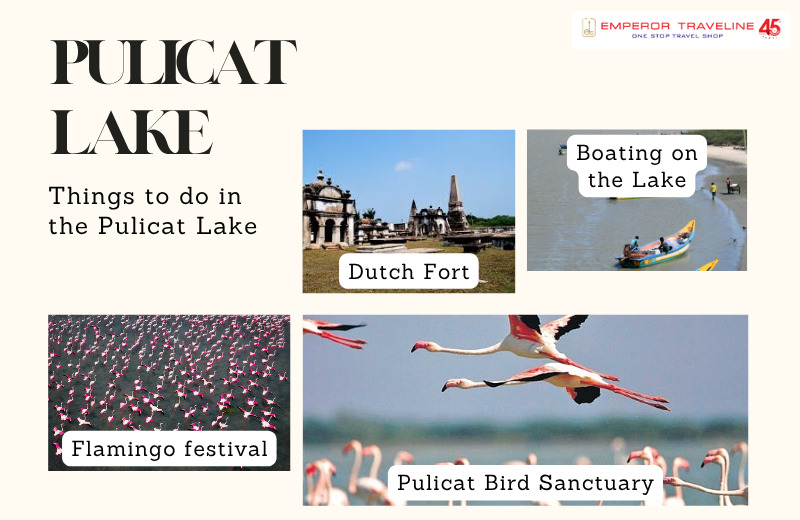Probably, you might have heard less about a lagoon—it is nothing but shallow water that is naturally separated from a sea or ocean. Pulicat lagoon in India is one of the notable coastal lagoons in Nellore, Andhra Pradesh, extending to more than 35 miles in length and about 10 miles in width. It is recognised to be the second largest brackish (mix of fresh and saltwater) lagoon in India, next to Chilika Lake, Odisha, which is about 40 miles in length.
!
!
History of Pulicat Lake
In the first few centuries, mariners in this port region called it the Podouke Emporion. However, later in the 13th century, Arabs migrated from Mecca and used it as their residence. Later, in the 16th century, the Portuguese occupied the region and colonised it. Then came the Dutch in the 17th century, and the Dutch East India Company was established for trading. After 1825, the British took control and used them as health resorts. Finally, after independence, Indian villagers used these lagoons for fishing.

Things to do in the Pulicat Lake
The Pulicat Lake tourism has numerous things to offer for tourists. The major ones include:
Exploring the Dutch Fort
The ruins of the Fort, Church, and Cemetery built by the Dutch in the early 17th century are still protected by the Archaeological Survey of India.
Boating on the Lake
Taking a boat ride on the lake is a must-do when visiting Pulicat. Tourists cannot miss this serene experience at the Lake.
Visiting the Pulicat Bird Sanctuary, Dutch Fort
Bird lovers, families travelling with children, and most importantly, wildlife photographers, have to include this sanctuary in their itinerary. Indeed, such an incredible activity!
Strolling the nearby coasts
A handful of small beaches are near the lake. So, visit them in early mornings or late evenings to watch the sunrise or sunset. Also, stroll along the coastal region with your partner.
Participating in the Flamingo festival, Pulicat Bird Sanctuary, Dutch Fort
In January, the Flamingo festival will take place and is amazing to watch flocks of flamingos arriving on the islands in the lagoon. Don’t miss it!
Look out for some Road trips to visit in South India!
Best time to visit Pulicat Lake
The ideal time to visit this tourist spot is between October and March or April for two reasons:
This period includes winter and spring, wherein tourists can enjoy the pleasant climate, visit nearby tourist destinations, relax, admire nature, etc.
In this period, the flamingos migrate from the Rann of Kutch and arrive at the Pulicate marshlands in huge flocks. Watching this is truly bliss for tourists and bird lovers.
Frequently asked questions:
How do I go to Pulicat Lake from Chennai?
The lake is just about 65–70 km away from Chennai, Tamil Nadu. So, it is easily accessible by all means. Be it road, bus, or train, you have to first reach Gummidipoondi as it is the nearest location to the lake. Then, you can choose to travel to the lake by the same or alternative modes.
Does the place house a bird sanctuary?
About 200 bird species inhabit the lake and the surrounding island villages. So, it is also a bird sanctuary. More than fifteen thousand Flamingos come in October and leave in April. So, they are unavoidable. Otherwise, you can also spot Rufous turtle dove, Yellow-throated sparrow, Garganey, Brown headed gull, Blue chat, Besra sparrow hawk, etc.
Where is Pulicat Lake located?
It is located on the border region of two major southern states in India—Andhra Pradesh and Tamil Nadu. However, jurisdiction-wise, it is considered a part of the Nellore or Tirupati district in Andhra Pradesh.
Is it a natural lake?
Of course, it is a natural lake formed along the Coromandel coast by the barrier island, Sriharikota. This island separates the lake from the great Bay of Bengal. However, a man-made canal, Buckingham Canal, runs through this lake but does not alter its natural formations.
Why is Pulicat Lake famous?
There is no doubt about whether it is famous or not. It is the second-largest natural brackish water lagoon in India. Moreover, the lake is inhabited by enormous flora and fauna, including a wide range of birds, mammals, and fish species.

